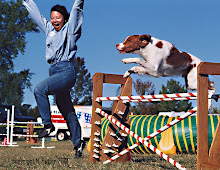[This was originally posted on the Fairmount Animal Hospital website on 13 October 2008.]
Dear Dr. Lee,
My Mom has an eight year-old Bichon that urinates in the house. Even when she lets him out, the minute she brings him in and leaves the room, he urinates. My Mom is beside herself and does not know what to do. This dog was a rescue, so we are wondering if maybe something happened in the dog’s past that makes him do that. Any help you can give me so I can help my Mom would be greatly appreciated.
Sincerely,
Stepsister of NotHousebroken
Dear Stepsister,
My first recommendation is to bring a first-of-the-morning urine sample to your veterinarian to rule out a medical problem.
I would also like to know if this dog actually urinates outside. Perhaps he has never been taught that outside is the desirable place to urinate. If this is the case, he may need to be retrained, starting from the very beginning. I highly recommend crate training as a method for housebreaking dogs (and puppies). The crate should only be large enough for the dog to lie down comfortably, and not so big that he can eliminate on one side and rest on the other side. Most dogs do not want to soil in their resting area, so this method trains their bladder to hold it. When you feel you dog might need to urinate (i.e. after waking from a nap), take him outside to his “place.” If he urinates, he can come back inside and spend some play time with you; if he does not, he goes back into the crate for 15 minutes, after which, you take him outside again. It may be helpful to place some urine-soaked paper towels or newspapers to the area in which you prefer him to use as his toilet so that it smells like a toilet.
It is important that your dog not be allowed to be out of your sight, lest he learn that he can urinate anywhere without consequence as long as you are not in view. You can keep your dog with you by using gates to block off access to out-of-sight rooms or using a leash to tether him to you (your waist, belt loop) or a doorknob or a heavy piece of furniture. If you are not able to monitor your dog’s behavior, put him back in his crate with a treat.
It can be helpful to teach your dog to eliminate on command. To train this command (Hurry up! Get busy! Go potty!), whenever you take your dog outside, repeat the command of your choice when he starts to exhibit behavior that precedes elimination – these behaviors can vary from dog to dog, but can include circling, pacing, and sniffing. Be sure to give verbal praise when your dog does ask you ask!
If your dog does urinate inside, be sure to clean the soiled area with an enzymatic cleaner. The enzymes degrade the molecules that make the odor. Dogs have an exquisitely sensitive sense of smell, and even if you can’t smell it, your dog might, and if it smells like his toilet, he might use it as his toilet.
Lastly, do not punish your dog for urinating in the house. Rubbing a dog’s nose into soiled areas will only make him anxious because if it happened more than 5 seconds ago, they will have no recollection that they did it, and therefore have no idea why he is being punished. In fact, it may make him more likely to avoid eliminating in your presence. If you do happen to catch him in the act of urinating, interrupt the behavior (screech, pick him up, clap your hands), take him outside, and praise him if he finishes the job outside.
Housesoiling can be a frustrating problem, but with some consistent training, most dogs can be taught to eliminate outside.
Sincerely,
Dr. Lee
My primary objective is to help pets and owners enjoy a more satisfying relationship with each other and maintaining the pet’s health to maintain the pet’s quality of life. Pets have the ability to enrich our lives immensely, and I feel that owners also have a responsibility to enrich their pets’ lives, too.
Got a pet behavior question?
E-mail me at fah@fairmountanimal.com.
